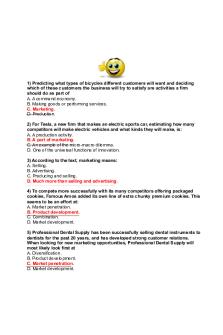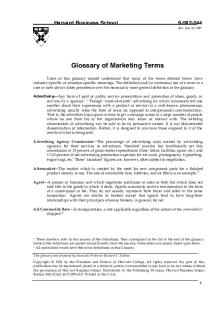MKT 520 - Zusammenfassung PDF

| Title | MKT 520 - Zusammenfassung |
|---|---|
| Author | Dalek Dalek |
| Course | Price and Product Management |
| Institution | Universität Mannheim |
| Pages | 3 |
| File Size | 53.4 KB |
| File Type | |
| Total Downloads | 68 |
| Total Views | 150 |
Summary
Zusammenfassung...
Description
MKT 520 1. Fundamentals of market research - Actuality - Objectivity - Precision - Relevance 3 Instrumental use of information * Instrumental use of information * Conceptual use of information * Symbolic use of information Quality assessment in market research 1. Objectivity (Independent form the researcher) 2. Reliability (free from random errors) 3. Validity (measure what it is supposed to measure) Step 1: Problem Formulation Step2: Determination of the research design What kind of study/research ? Descriptive:Describes characteristics of objects Exploratory:Clarify ambiguous situations or discover ideas (Find out which is relevant) Factor analysis/ Cluster Analysis Explanatory:seeks to identify cause and effect relationships (Test theories) Analysis of variance/ Regression Analysis Step3: Determination of the executing researcher Profound knowledge Substantial experience
Lower costs Greater Objectivity
2. Determination of the data collection method Primary data vs. Secondary data Primary Research: Behavior directly captured Advantages: Often the only option, Inexpensive, No Interviewer Bias Disadvantages: Observation Bias, Hard to reproduce, Risk of an insufficient observation Mixed forms between survey and observation: Experiment & Panel Experiment : Laboratory Experiment/Field Experiment Panel: Consumer Panel/Retail Panel/Special Panel Experiment: Central principle: Active variation of one variable and capturing the effect on dependent measures. Variables: Independent, dependent and confounding
Fundamental Desgin issues Experimental Setting
Randomization
Basis of comparison
Panel Research Panel : Definite, consistent circle of people which are in principle surveyed about the same object of study in regular intervals. Internal Data vs. External Data Internal Data: Sales Figures, Accounting records, Customer Data External Data: international & national / commercial & non-commercial Big data ---> Secondary data 3. Sampling Sample: Refers to a subset, or some part, of a larger population from which information is gathered during the market research process. Census or Sample ? 4. Design of the research instrument Operationalization represents the development of scales for measuring characteristic values of a particular concept. Scale measurement defines the mathematical characteristics of a scale and thereby the quality of the data to be gathered. 5. Data Collection 6. Editing and coding of data Editing ensures the availability, readability and the absence of errors Coding : Mutual Exclusion/ Completeness avoid the loss of information 7. Analysis and interpretation of data Descriptive Statistics: Univariate / Bivariate Factor Analysis: A factor is a linear combination of the original variables. - Reflective measurement: Latent constructs cause the measured variables - Formative measurement: Measured variables cause the construct Procedure: 1. Create the data matrix 2. Calculate of the input data (correlation matrix) 3. Determine the number of factors to be retained 4. Rotate and interpret the factors
Determine the number of factors to be retained Goal: Extraction of uncorrelated factors Latent Root Criterion - Factors with eigenvalues ( =...
Similar Free PDFs

MKT 520 - Zusammenfassung
- 3 Pages

Real Decreto 520-2005 - RD 520/2005
- 45 Pages

520 citibank 3
- 2 Pages

Bsbpmg 520 Assessment Tasks
- 17 Pages

ISA 520 ANALTICAL PROCEDURES
- 8 Pages

Syllabus ECON 520 Fall2019
- 6 Pages

Short Paper one- MBA 520
- 4 Pages

TCH 520 T1 Brain Facts
- 6 Pages

MKT 421solution
- 12 Pages

TP 2 MKT 2 90% - Tp2 MKT
- 10 Pages

TP 3 MKT 2 80% - Tp3 MKT
- 10 Pages

MKT 421solution
- 10 Pages

MKT 421solution
- 10 Pages

MKT Glossary
- 24 Pages
Popular Institutions
- Tinajero National High School - Annex
- Politeknik Caltex Riau
- Yokohama City University
- SGT University
- University of Al-Qadisiyah
- Divine Word College of Vigan
- Techniek College Rotterdam
- Universidade de Santiago
- Universiti Teknologi MARA Cawangan Johor Kampus Pasir Gudang
- Poltekkes Kemenkes Yogyakarta
- Baguio City National High School
- Colegio san marcos
- preparatoria uno
- Centro de Bachillerato Tecnológico Industrial y de Servicios No. 107
- Dalian Maritime University
- Quang Trung Secondary School
- Colegio Tecnológico en Informática
- Corporación Regional de Educación Superior
- Grupo CEDVA
- Dar Al Uloom University
- Centro de Estudios Preuniversitarios de la Universidad Nacional de Ingeniería
- 上智大学
- Aakash International School, Nuna Majara
- San Felipe Neri Catholic School
- Kang Chiao International School - New Taipei City
- Misamis Occidental National High School
- Institución Educativa Escuela Normal Juan Ladrilleros
- Kolehiyo ng Pantukan
- Batanes State College
- Instituto Continental
- Sekolah Menengah Kejuruan Kesehatan Kaltara (Tarakan)
- Colegio de La Inmaculada Concepcion - Cebu

